|
|
|
Sort Order |
|
|
|
Items / Page
|
|
|
|
|
|
|
| Srl | Item |
| 1 |
ID:
167719
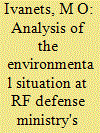

|
|
|
|
|
| Summary/Abstract |
The paper analyzes the environmental situation at the Russian MoD facilities in the Arctic Zone on the basis of aerospace survey.
|
|
|
|
|
|
|
|
|
|
|
|
|
|
|
|
| 2 |
ID:
073602
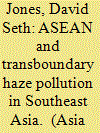

|
|
|
|
|
| Publication |
2006.
|
| Summary/Abstract |
In recent decades the countries of Southeast Asia have been affected by air pollution (commonly called haze) arising from the burning of vegetation by small holders, plantation owners and logging companies. This is done in order to clear or rejuvenate the land for cultivation and planting and can occur at particular times during the year, most noticeably in the periods March to May and August to October. The burning has resulted in widespread forest fires and has been particularly intense in years when the weather has been noticeably dry due to the effects of the El Nino phenomenon. By far the main source of forest fires caused by small holders and plantation owners has been Indonesia. The smoke from the forest fires has not only caused widespread air pollution in Indonesia itself but also in neighbouring countries, resulting in what is termed as transboundary air pollution. This has affected, amongst other things, public health, bio-diversity, tourism, air transport, and agricultural production. So serious have the effects been that the member states of the Association of Southeast Asian Nations (ASEAN) were prompted from 1990 to collaborate in tackling the problem and to embark upon a series of joint initiatives for that purpose. After discussing the extent of forest burning in Indonesia, its causes and effects, the article will examine and assess the initiatives mentioned above, culminating in the ASEAN Agreement on Transboundary Haze Pollution, which came into effect in November 2003. The paper will then examine a crucial impediment to the effective implementation of the initiatives: viz. the standards of governance and administration in Indonesia. In conclusion, the paper will consider the challenges to be overcome to enable the aims of the ASEAN initiatives to be realised, and also, by examining these initiatives, what conditions are necessary to ensure that international agreements affecting domestic policy and administration in signatory states, have a genuine impact and achieve their goals.
|
|
|
|
|
|
|
|
|
|
|
|
|
|
|
|
| 3 |
ID:
059212
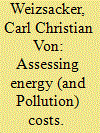

|
|
|
| 4 |
ID:
176771


|
|
|
|
|
| Summary/Abstract |
With rapidly expanding real GDP in Vietnam, it is anticipated that the Vietnamese energy production will increase to meet its rising energy consumption. An important corollary is that pollution will also rise since the energy sector is considered a big polluter in the developing world. This paper brings two important insights to this literature: first and foremost, this paper seeks to establish if any behavioural biases of policy makers have clouded the decision to adopt suitable energy technologies and policies in Vietnam with far-reaching consequences for sustainability in the region. Secondly, in order to detect behavioural biases, it considers the asymmetric effects of increases vis-à-vis decreases in regressors by using the non-linear autoregressive distributed lags (NARDL) models, to examine how such increases or decreases really impact on pollution in Vietnam. Using annual data from 1982 to 2015, the analysis finds that the long-run relationships between pollution, energy use and oil prices have been characterised by non-linear and asymmetric interlinkages to indicate hidden cointegration. We further argue that such hidden cointegration can signal important behavioural biases in (energy) policy-making.
|
|
|
|
|
|
|
|
|
|
|
|
|
|
|
|
| 5 |
ID:
017995
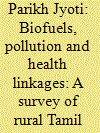

|
|
|
|
|
| Publication |
Nov 18, 2000.
|
| Description |
4125-4137
|
|
|
|
|
|
|
|
|
|
|
|
|
|
|
|
| 6 |
ID:
122813


|
|
|
| 7 |
ID:
192178
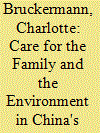

|
|
|
|
|
| Summary/Abstract |
In the “coal province” of Shanxi, residents grapple with tensions between caring for their families and caring about their environment. In creating ethical pathways through care, residents must navigate the paradox of livelihoods dependent on forms of development that endanger lives and pollute environments. This dilemma has crystallized over time, as the personal and particular demands of the present have become enmeshed with long-standing concerns over environmental degradation. Rather than characterizing family care as concrete and environmental care as abstract, acts of care in Shanxi link the reproductive crisis of the family with the reproductive crisis of the environment: the article presents instances under which the attention, empathy and recognition of care for concrete others are scaled up to the levels of ecology and planetary crisis.
|
|
|
|
|
|
|
|
|
|
|
|
|
|
|
|
| 8 |
ID:
090888


|
|
|
|
|
| Publication |
2009.
|
| Summary/Abstract |
This article outlines the gravity of the environmental crisis-pollution, climate change, overpopulation and the unpredictable environmental impacts from our use of science and technology and exploitation of natural resources. We must put the 'eco' back into economics and realise what the conditions and principles are for truly sustainable living. We have to set a new bottom line, a bottom line dictated by the reality that we are biological creatures, completely dependent for our survival and well-being on clean air, clean water, clean soil, clean energy and biodiversity. We are social animals who need strong families and supportive communities, full employment, justice, equity and security and freedom from racism, terror, war and genocide. And we remain spiritual beings who need sacred places in the natural world that gave us birth.
|
|
|
|
|
|
|
|
|
|
|
|
|
|
|
|
| 9 |
ID:
161448
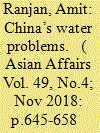

|
|
|
|
|
| Summary/Abstract |
This article looks at the problems facing China in regard of its water supply and usage. It considers China's available water resources and their uses, the growing water pollution, and the water management system adopted by China to secure the country's future. This includes small and large-scale projects, dams, the South-to-North Water Diversion Project/South-North Water Transfer Project (SNWDP/SNWTP) or Nanshuibeidiao, and the Sponge Cities Initiative. It also looks at some of the policy issues and relevant legislative frameworks developed to respond to the problem. This article argues that despite the measures taken by the Chinese government, water remains an area of concern for China.
|
|
|
|
|
|
|
|
|
|
|
|
|
|
|
|
| 10 |
ID:
182760
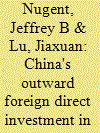

|
|
|
|
|
| Summary/Abstract |
Because of the potentially large and important effects of the extremely ambitious Belt and Road Initiative (BRI) launched by China in late 2013, considerable attention has been given to the motives for, and repercussions of, the BRI-driven infrastructural projects. Yet, the non-infrastructural outward foreign direct investment (FDI) from China to BRI countries, which varies quite substantially across different sectors and different countries, has not yet received much attention. In contrast to some recent studies showing that the massive initiative has increased China's total FDI outflows to fellow BRI countries, in this paper, based on our sector-level difference-in-differences models, we find that effect to be statistically insignificant. Yet, at the same time, we provide empirical evidence on the sectoral pattern of China's outward FDI before and after 2014 indicating that China's FDI outflows to BRI countries have significantly increased in sectors characterized by overcapacity and contributing to pollution in China, thereby demonstrating that China's BRI-driven outward FDI has been very selective in terms of sectors. We confirm these findings with a variety of robustness checks and show that it is BRI countries with relatively low institutional quality that have been more likely to receive these types of FDI from China. We thus speculate that Chinese firms have been motivated to place FDI investments in BRI countries for the sake of alleviating China's own overcapacity and pollution problems. Our findings lead us to suggest that, although these sectoral patterns are consistent with the different stages of economic development in which China and its fellow BRI-identified countries find themselves, Chinese investors and host country governments should be more concerned with the potential for unwanted side-effects of the FDI investments so that the mutually beneficial effects of the BRI can be sustained into the indefinite future among all countries involved.
|
|
|
|
|
|
|
|
|
|
|
|
|
|
|
|
| 11 |
ID:
166576
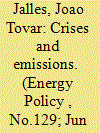

|
|
|
|
|
| Summary/Abstract |
In this paper, we empirically assess by means of the local projection method, the impact of different types of financial crises on a variety of pollutant emissions categories for a sample of 86 countries between 1980 and 2012. We find that financial crises in general lead to a fall in CO2 and methane emissions. When hit by a debt crisis, a country experiences a rise in emissions stemming from either energy related activities or industrial processes. During periods of slack, financial crises in general had a positive impact on both methane and nitrous oxide emissions. If a financial crisis hit an economy when it was engaging in contractionary fiscal policies, this led to a negative response of CO2 and production-based emissions.
|
|
|
|
|
|
|
|
|
|
|
|
|
|
|
|
| 12 |
ID:
151584
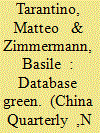

|
|
|
|
|
| Summary/Abstract |
Significant efforts towards environmental transparency have been made by the Chinese government since 2008. This paper focuses on the technical decisions shaping a database of official pollution information built and operated by a Chinese NGO known as the Institute of Public and Environmental Affairs (IPE). Issues of standardization, power distribution and institutional fragmentation are discussed. The paper illustrates a case of NGOs integrating enforcement capabilities as data centres amidst the growing reliance on processes of informational governance of environmental issues.
|
|
|
|
|
|
|
|
|
|
|
|
|
|
|
|
| 13 |
ID:
095971
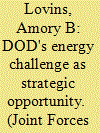

|
|
|
| 14 |
ID:
178580
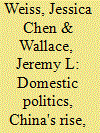

|
|
|
|
|
| Summary/Abstract |
With the future of liberal internationalism in question, how will China's growing power and influence reshape world politics? We argue that views of the Liberal International Order (LIO) as integrative and resilient have been too optimistic for two reasons. First, China's ability to profit from within the system has shaken the domestic consensus in the United States on preserving the existing LIO. Second, features of Chinese Communist Party rule chafe against many of the fundamental principles of the LIO, but could coexist with a return to Westphalian principles and markets that are embedded in domestic systems of control. How, then, do authoritarian states like China pick and choose how to engage with key institutions and norms within the LIO? We propose a framework that highlights two domestic variables—centrality and heterogeneity—and their implications for China's international behavior. We illustrate the framework with examples from China's approach to climate change, trade and exchange rates, Internet governance, territorial sovereignty, arms control, and humanitarian intervention. Finally, we conclude by considering what alternative versions of international order might emerge as China's influence grows.
|
|
|
|
|
|
|
|
|
|
|
|
|
|
|
|
| 15 |
ID:
121202
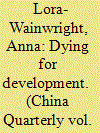

|
|
|
| 16 |
ID:
118828
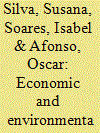

|
|
|
|
|
| Publication |
2013.
|
| Summary/Abstract |
We build a general equilibrium model with renewable (non-polluting) and non-renewable (polluting) resources to analyze the interaction and compatibility between economic growth and a cleaner environment. The study is in two phases: (i) resource extraction/production costs are constant; (ii) resource producers invest in knowledge to reduce extraction/production costs, endogenizing technical change. With constant costs, there is a permanent trade-off between economic growth and a cleaner environment. With endogenous technical change, it is possible to harmonize more output and less emissions by replacing non-renewable resources for renewable ones. We also conduct a sensitivity analysis to explore three specific policy actions. With constant costs, the best policy action is the imposition of a higher renewable resources standard, while with endogenous technical change, under certain conditions, all policy interventions may benefit both the economy and the environment.
|
|
|
|
|
|
|
|
|
|
|
|
|
|
|
|
| 17 |
ID:
105779
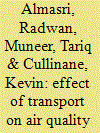

|
|
|
|
|
| Publication |
2011.
|
| Summary/Abstract |
Statistics show that the number of cars per capita in Syria is still low, but that the figure has more than doubled since 2004. Syria also suffers from inadequate public transport provision, poor infrastructure and the absence of suitable traffic management systems, with the average speed of road transport in Damascus at about 4-5 km/h. Only until very recently, a comprehensive network for the continuous monitoring of air pollutants has been lacking. This paper reviews, collates and synthesises the results of numerous studies of Syrian road transport, with an emphasis on air pollution from Syria's transport and energy production sectors. It is revealed that what studies that have been done show that the air quality in Syrian urban areas falls below established national air quality standards, especially during winter when the demand for heating is high. The paper proposes a number of suggestions to improve air quality in Syria by using greener and more public transport, promoting and incentivising rational and efficient energy consumption in all sectors, taking advantage of available renewable energy resources, establishing an active network for routine measurement of pollution, setting local emissions standards that are in line with international standards and which are supported by the imposition of penalties, fines or taxation on polluting agents.
|
|
|
|
|
|
|
|
|
|
|
|
|
|
|
|
| 18 |
ID:
078756
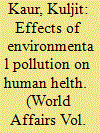

|
|
|
| 19 |
ID:
059112
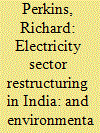

|
|
|
| 20 |
ID:
186238
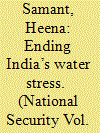

|
|
|
|
|
| Summary/Abstract |
India is facing water distress in both quality and quantity. This is expected to worsen if urgent all-round remedial measures being taken prove to be inadequate. Water shortages, pollution, overuse and significant wastage, low to no water pricing, floods in monsoon when water is abundant, among others, characterise the prevailing situation in parts of the country. Several factors, such as exponential population growth, rapid urbanisation, industrialisation, antiquated infrastructure, and inadequate water governance, can be credited for this plight. There are major reforms and changes underway that raise hopes for a more secure future. The Government has made ‘water governance’ one of the main priorities in its policies and decisions, and significant advances in overcoming water related challenges are being made. Despite these measures, a crisis could still be inevitable due to the challenges posed by climate change. India needs to make its people conscious of the finite nature of water and the utmost need to avoid waste and overuse. They need to learn to nurture, conserve, reuse, and recycle this invaluable resource of nature.
|
|
|
|
|
|
|
|
|
|
|
|
|
|
|
|
|
|
|
|
|